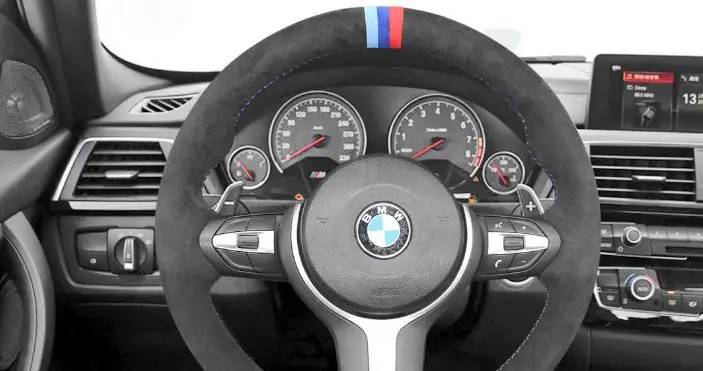Steering wheel covers: they’re not just about adding a touch of personality or style to your vehicle’s interior. These seemingly simple accessories offer a blend of functional and aesthetic benefits that many car owners have come to appreciate. From safeguarding the original steering wheel surface to enhancing grip and ensuring comfort, there’s more to steering wheel covers than meets the eye.
As driving is an integral part of many people’s daily lives, ensuring that the driver’s primary touchpoint – the steering wheel – is comfortable and protected becomes paramount. This post will delve deep into the world of steering wheel covers, demystifying everything from the nuances of steering wheel sizes to the installation intricacies of various cover types.
Whether you’re a car enthusiast or someone looking to spruce up their ride, buckle up as we take you on a journey through the essentials of steering wheel covers
Understanding Steering Wheels – Does One Size Fit All?
Steering wheels, while consistent in their primary function, vary significantly in design, size, and the materials used in their construction. These variations aren’t just aesthetic choices but can also be informed by the car’s primary function, the manufacturer’s design ethos, or the intended driving experience.
Size and Fit Considerations:
-
Are all steering wheels the same size?
- The simple answer is no. Steering wheels come in various diameters and grip circumferences. While many passenger cars have steering wheels ranging between 14 to 17.5 inches in diameter, trucks, SUVs, and other larger vehicles might have larger sizes. The thickness of the grip also varies, impacting the driver’s comfort and control.
-
Importance of Sizing for Covers:
- It’s imperative to choose a cover that matches the size and grip circumference of your steering wheel. A too-tight cover can warp or damage over time, while a loose one can slip, posing safety risks.
-
Universal fit vs. model-specific covers:
- Some steering wheel covers claim a ‘universal fit,’ suitable for a range of sizes. While these might be convenient, they might not offer the snug fit of a model-specific cover. On the other hand, model-specific covers are designed with particular steering wheel sizes and grip circumferences in mind, ensuring a better fit but with a limited range of compatibility.
In the quest for the perfect steering wheel cover, understanding your steering wheel’s size and nuances is the first step.
What Are Steering Wheel Covers Exactly?
Steering wheel covers are tailored sheaths, typically made from materials like leather, cloth, or silicone, designed to wrap around a steering wheel. They enhance grip, protect the wheel from wear and tear, and provide comfort against temperature extremes.
Diving deeper into the world of these essential car accessories, one realizes that steering wheel covers serve purposes beyond mere aesthetics:
- Primary Purposes:
- Steering wheel covers act as a protective and functional overlay for the original steering wheel. They are crafted to fit snuggly, ensuring that the tactile experience of driving is both comfortable and safe.
- Advantages of Steering Wheel Covers:
- Comfort: The primary function of many steering wheel covers is to shield drivers from the discomfort of extreme temperatures. A parked car in summer can lead to a painfully hot steering wheel, just as winter can make it cold and unwelcoming. A cover acts as a thermal barrier, making the driving experience more pleasant.
- Grip: Especially for wheels that have seen wear over the years, a cover can restore or enhance grip, offering more control and reducing driver fatigue.
- Aesthetics: With a plethora of designs, colors, and materials available, steering wheel covers can be a personal statement, allowing drivers to customize their vehicle’s interior to their liking.
- Protection: Over time, the continuous handling can cause a steering wheel to degrade, fade, or even crack. Covers help protect against this wear, ensuring the longevity of the wheel beneath.
Different Types of Steering Wheel Covers
Steering wheel covers, while seemingly straightforward, come in a variety of materials and attachment mechanisms, each catering to different needs and preferences. Let’s delve into the various types available, highlighting their unique attributes.
Material Types
-Leather Steering Wheel Covers:
Leather covers exude luxury and elegance. Durable and offering a comfortable grip, they age gracefully and are a popular choice among those driving premium vehicles or those desiring a touch of sophistication.
-Cloth Steering Wheel Covers:
Light and often machine-washable, cloth covers are versatile in design. They provide comfort in extreme temperatures and can be personalized with a wide array of colors and patterns.
-Silicone Steering Wheel Covers:
Famed for their durability and non-slip grip, silicone covers are a practical pick. They are resistant to extreme temperatures and are straightforward to clean, making maintenance a breeze.
-Wood Grain Steering Wheel Covers:
These covers cater to those looking for a vintage or classic appeal. While they offer a unique aesthetic and firm grip, care is essential to prevent potential wear or damage.
Attachment Types
-Slip-on Steering Wheel Covers:
The easiest to install, slip-on covers are designed to simply slide over the wheel. With an elastic component ensuring a snug fit, they are user-friendly and efficient.
-Stitch-on Steering Wheel Covers:
Offering a customized fit, stitch-on covers require users to manually stitch the cover onto the wheel. They may be more time-consuming to install, but the tight fit ensures they remain firmly in place.
Guide to Installing Different Types of Covers
Installing a steering wheel cover accurately is essential for both safety and aesthetics. The process requires careful consideration, precision, and a touch of patience. Here’s a comprehensive guide for two primary installation methods:
Preparation Steps for All Types:
- Clean the Steering Wheel:
- Materials Needed: Mild soap, water, soft cloth or sponge.
- Steps: Mix a few drops of mild soap with water. Dampen the cloth or sponge and wring out excess water. Gently scrub the steering wheel surface to remove any dirt, grease, or grime. Once cleaned, use a dry cloth to wipe the wheel and let it air dry completely to ensure no moisture remains.
- Temperature Consideration:
- Why It Matters: Materials expand or contract in extreme temperatures.
- Tips: Ideally, aim for room temperature conditions. If in cold weather, consider keeping the steering wheel cover indoors before installation. In hot climates, avoid leaving the cover in direct sunlight as this can cause overstretching.
- Gather Necessary Tools/Materials:
- For Slip-on Covers: Just the cover.
- For Stitch-on Covers: The cover, provided laces or threads, a needle (preferably one with a large eye for easy threading), and clips or clothespins for securing.
Installing Slip-on Covers:
- Position the Cover:Hold the steering wheel cover with both hands. Ensure the top (often marked or noticeably shaped) aligns with the top center of the steering wheel, especially if there’s a specific pattern or logo.
- Stretch and Fit:Gently stretch the top part of the cover over the top of the steering wheel, ensuring even placement. Slowly work your way downwards, using your fingers and palms to evenly distribute and stretch the material. This might require both pushing and pulling until the cover encompasses the entire wheel.
- Adjust and Settle:Once it’s on, run your hands around the entire circumference, smoothing out any wrinkles or bubbles. Ensure the inner seam aligns perfectly with the edge of the steering wheel for a seamless appearance.
Installing Stitch-on Covers:
- Position and Align:Drape the cover over the steering wheel, ensuring all design elements or ergonomic features are properly aligned. Ensure the holes or loops for stitching are accessible and line up on both sides.
- Secure with Clips (optional):Starting from the top center, use clips or clothespins to temporarily secure the cover in place. This ensures even tension and alignment as you stitch. Space the clips evenly for consistent support.
- Begin Stitching:Thread the needle with the provided lace or thread. Starting from one end (preferably the top center), insert the needle through the first set of aligned holes or loops, pulling until there’s an equal amount of thread on either side. Proceed with a basic over-and-under stitch, ensuring consistent tension throughout.
- Tie and Secure:Once you’ve gone full circle, tie the two ends of the thread securely, ensuring the knot is tight and discreet. Trim any excess thread but leave a little slack to ensure the knot doesn’t come undone.
- Adjust and Test:Smooth out the cover, ensuring no misalignments or puckering. Turn the wheel in all directions to test its grip and check if the cover remains securely in place.
Tips for Both Installation Types:
- Ensuring a Snug Fit:
- After installation, the cover should be taut but not overly strained. It should not move or twist when you grip or turn the wheel.
- Post-installation Checks:
- Periodically check for signs of wear or loosening, especially after extensive driving or exposure to extreme conditions.
- Regular Adjustments:
- If you notice any part of the cover starting to sag or lose its grip, adjust as needed. For stitch-on covers, periodic tightening of the stitches might be necessary.
Remember, the key to a successful steering wheel cover installation is patience. Taking the time to ensure each step is done correctly will result in a smooth, safe, and aesthetically pleasing outcome.
Caring for Your Steering Wheel Cover
Once you’ve successfully installed your steering wheel cover, it’s crucial to care for it to ensure longevity and sustained appeal. Steering wheel covers, irrespective of their material, are subjected to daily wear and tear, along with exposure to various environmental factors like sunlight, moisture, and heat. Here’s a detailed guide on how to look after your steering wheel cover based on its material:
Leather Covers:
- Regular Dusting:
- Why: Leather tends to attract dust which can eventually cause wear on its surface.
- How: Use a soft, dry cloth to gently wipe down the cover, removing any loose dust or debris.
- Conditioning:
- Why: Leather can dry out and lose its luster over time. Conditioning helps maintain its suppleness.
- How: Every few months, apply a leather conditioner. This keeps the leather soft and prevents it from cracking. Ensure you follow the product instructions and test on a small area first.
- Avoid Direct Sunlight:
- Why: Prolonged exposure can fade and dry out leather.
- How: When parking, try to find shaded areas or use sun shades to minimize direct sunlight on the wheel.
Cloth Covers:
- Regular Cleaning:
- Why: Cloth covers can accumulate dirt and absorb spills or moisture.
- How: Depending on the manufacturer’s instructions, some cloth covers can be machine-washed, while others should be spot-cleaned using mild soap and water.
- Drying:
- Why: Leaving cloth covers damp can cause mold or mildew to form.
- How: Always air dry after washing. Avoid wringing out the cloth as it can distort its shape.
Silicone Covers:
- Wiping Down:
- Why: Silicone can collect dust and might become slippery if oily.
- How: Use a damp cloth with mild soap to wipe down the cover, then dry it with a soft cloth.
- Avoid Sharp Objects:
- Why: Sharp objects can cause cuts or punctures in the silicone.
- How: Be cautious when placing items like keys or tools near the steering wheel.
Wood Grain Covers:
- Polishing:
- Why: Over time, wood grain can lose its shine.
- How: Use a wood-safe polish to maintain its sheen. Always read product instructions and test on an inconspicuous area first.
- Avoid Excess Moisture:
- Why: Wood can warp or crack if exposed to too much moisture.
- How: Never leave the cover wet. If it gets damp, wipe it down and let it air dry thoroughly.
General Tips for All Covers:
- Rotate Periodically: This helps ensure even wear, especially if you have specific grip patterns or habits.
- Check for Damage: Regularly inspect your cover for signs of wear, tears, or damage. Early detection means timely replacement or repair, ensuring safety.
- Avoid Chemical Cleaners: Unless specified by the manufacturer, avoid using harsh chemical cleaners as they might damage the material or fade the color.
A little care goes a long way. Proper maintenance not only ensures that your steering wheel cover lasts but also keeps your driving experience comfortable and safe.











